Alaska Fish & Wildlife News
April 2022
A Tern of Events
Alaska’s Elusive Aleutian Tern
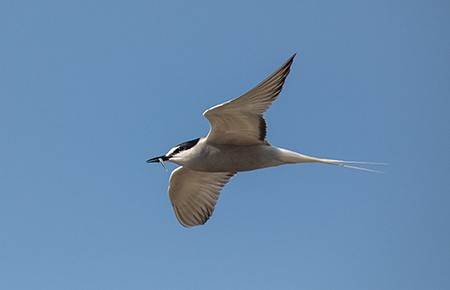
Seabirds are one of my favorite groups of wildlife in Alaska. Living in Kodiak and traveling via skiff, I loved seeing murres and cormorants standing sentry on the rocky islands, and puffins and seagulls erupting from the water as we drove by. Studying puffins later in my life, I appreciated how seabirds create a link between ocean and coastal ecosystems in the north. Seabirds migrating north bring the resources of warmer southern oceans, and the food and nutrients they provide the shoreline ecosystems of Alaska are vital to the other plants and animals there. Nearly 50 million seabirds nest on Alaska’s coast every summer – 90 percent of all the seabirds in the country. Among these seabirds are the world’s longest distance migrant, the Arctic Tern, and the lesser-known Aleutian Tern, whose entire continental population breeds in Alaska.
Most Alaskans recognize Arctic Terns, a small red-beaked bird, as many a beachgoer has had a pleasant walk turn into a jog while territorial Arctic Terns swoop in from above, crying out, and defending their nests. Far fewer Alaskans have seen the elusive Aleutian Tern, who nest and forage all along coastal Alaska from Southeast to the Chukchi Sea during the summer months in June to August. It is the Aleutian Tern whose population is estimated to be one of the smallest global tern populations in the world and who has become a topic of conservation concern in recent years, recently being listed as “Vulnerable” by the International Union for the Conservation of Nature (IUCN.)
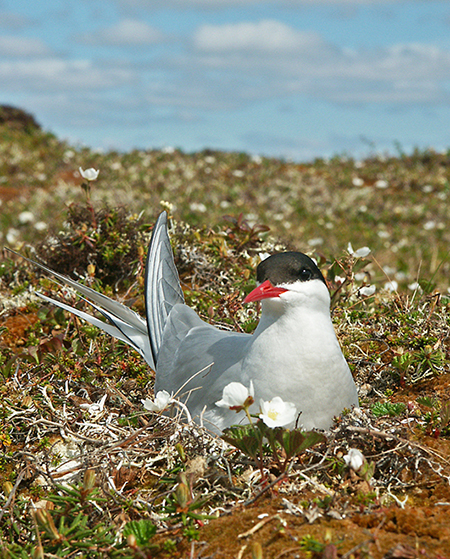
Both Tern species have overlapping ranges and they regularly nest together within the same colonies. To the untrained eye, a colony may appear as one homogenous tern species, but a closer look can show a few notable differences. During the breeding season (March-October) Arctic Terns have bright red beaks and feet while Aleutian Terns have black beaks and feet. Both species sport a little black cap, with the Arctic’s being a solid hood covering the eyes and head, while Aleutian Terns show their bright white forehead under a black cap and face mask, like a bandit from an old Western movie. Fittingly, Aleutian Terns are also difficult to track.
Terns in Trouble?
In 2015, a study found that Aleutian Tern populations in colonies across the Aleutian Islands, Bering Sea, Chukchi Sea, Gulf of Alaska, and Kodiak Island had declined by 93 percent in the last 40 years. In response, the Aleutian Tern Technical Committee (ATTC) was formed to learn more about these colony declines and investigate possible causes. Was it truly a population decline across the entire global range of the Aleutian Tern? Or were the birds simply relocating due to environmental changes? Many Aleutian Terns also nest in Russia, but are these two populations genetically separate?
The first step to answer these questions was to conduct a statewide survey to find the true status of the Aleutian Tern in Alaska. Then the ATTC set out to test and develop potential tools for surveying the elusive and finnicky seabird colonies in a state with 44,000 miles of shoreline.
Tools for Tallying Terns
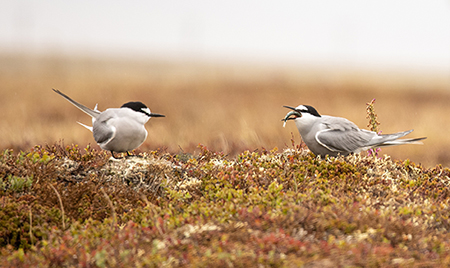
Needless to say, Aleutian Terns are difficult to study. They do not often return to the same breeding sites year after year, they tend to abandon nests if disturbed, and they have unpredictable movements and behavior, making them hard to track. “They are really flighty, prone to disturbance, and they will abandon a nest even if they have already laid or have chicks,” says Jenell Larsen Tempel, a biologist with the Threatened, Endangered, and Diversity Program who assisted with the pilot season of Aleutian Tern surveys in Alaska.
Despite these exasperations, the ATTC employed many different methods to estimate current Aleutian Tern numbers in Alaska. This included counting birds by boat and land, aerial surveys, drone images, and even getting audio recording of noisy colonies to estimate abundance. Historically, observers counted birds individually from afar as the standard method of counting seabirds. I have spent many an hour growing slowly more seasick on a boat as I watched Thick-billed Murre colonies through binoculars for ten minutes at a time, unable to move my gaze without risking losing count. While useful, this method can also be hard to replicate as it relies on the expertise of individual birders. It is more recently that aerial and drone surveys have been used to cover more area.
Last year was the first year the ATTC set these survey methods into motion for Aleutian Terns. To start, aerial surveys were tested out in Bristol Bay to see if they could be used across the entire state. A pilot and observer took to the skies to scan coastline for white specks indicative of tern colonies. Once spotted, the plane would descend so the Arctic and Aleutian Terns could be counted. While it was thought that this team could land nearby and supplement data with ground surveys, the unpredictable and tumultuous nature of remote Alaskan environments often made this impossible. Nonetheless, after nine days of aerial surveys and two days of ground counts, 49 tern colonies were found, with 10 colonies showing Aleutian Terns present.
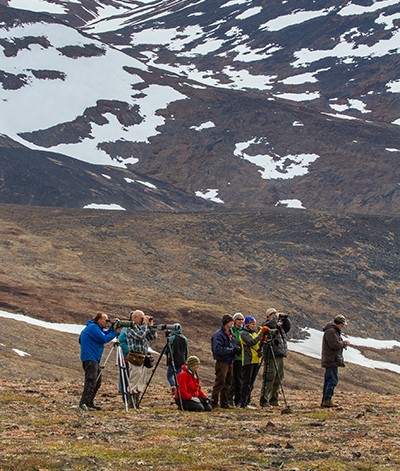
Citizen Scientists in Nome are also a part of the acoustic monitoring program that records bird calls at nesting sites. These call rates can then be used to estimate abundance of the terns recorded. Automatic detection and call monitoring methods like these can be useful tools when monitoring species that are difficult to study, find, or that nest in difficult to access locations. The flighty, rare, and Nome-nesting Aleutian Tern certainly fits the bill.
Research in 2018 by Goldstein et al. also set out to track the Aleutian Terns once they left their summer breeding colonies in Alaska. For migratory birds, many threats can arise during the other half of their lives when they leave for the winter, knowing these locations can then help to document potential threats. After six years of data collection, recovered geolocator tags on returning terns revealed the little seabirds were migrating nearly 10,000 miles between Alaska and areas in Indonesia, the Philippines, and Borneo. It is one of the longest terrestrial vertebrate migrations ever recorded.
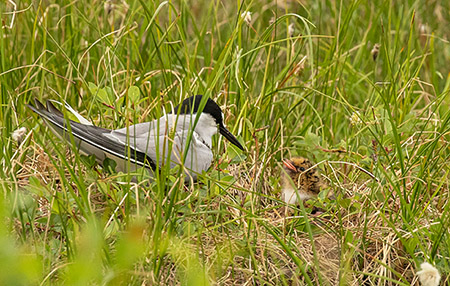
With this promising new data and successfully tested survey methods, the ATTC will launch the first statewide survey effort for Aleutian Terns in 2023! Research on this species is ongoing and thorough. Going forward, up-to-date tern numbers, as well as the data on their movements, will help illuminate the true status of the Aleutian Tern in North America and highlight potential actions for their management and conservation in Alaska.
Being Tern Friendly
Alaska has some of the most incredible coastlines on the continent and we share many of these beaches and environments with seabirds and tern colonies. The easiest way to be tern-friendly in your community is to be mindful of your outdoor activities where they overlap with tern habitat.
ADF&G biologist Jenell Larsen Tempel cautions that Aleutian Terns may abandon a nest even if a dog simply walks by, they are very flighty and easily disturbed. If you’re walking in coastal areas where terns may be nesting, keep your dog on a leash, avoid colonies, and watch where you step as tern nests are usually just depressions in the ground with well camouflaged eggs. As with many coastal bird’s nests, they can be almost invisible unless you are watching carefully. Nesting locations near trails or roads are easy to access but try to avoid walking through the nesting habitat. If you do wish to observe nesting terns or photograph them, try to do so while staying in one spot to minimize disturbances.

Reporting sightings of Aleutian Tern colonies can also help researchers find new locations to monitor, so keep an eye out for the small white terns with a black bandana and beak. They are a rare sight, and this is the only state they can be found in in all of North America! Sighting reports can be emailed to U.S. Fish and Wildlife Service biologists at AK_MBM@FWS.GOV - a subject line like “Aleutian tern sighting” is helpful.
Short video of an Aleutian tern by Jill Tengeres, a graduate student at Oregon State University studying Aleutian Terns' diet.
Support the TED Program by purchasing this year’s Conservation Stamp featuring a Bluethroat!
Follow the TED Program on Facebook and Instagram
Arin Underwood is a wildlife biologist with ADF&G’s Threatened, Endangered, and Diversity Program. She works with citizen science projects and supports research on birds and small mammals in Southcentral Alaska.
Subscribe to be notified about new issues
Receive a monthly notice about new issues and articles.
